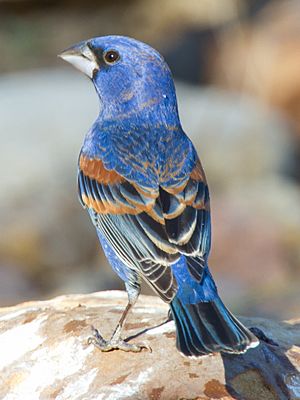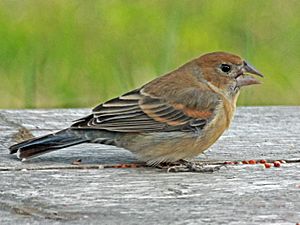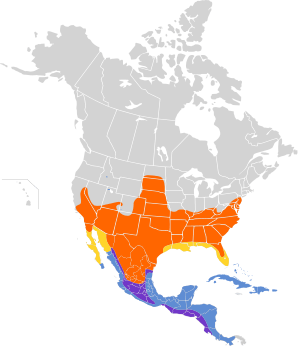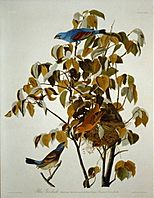Blue grosbeak facts for kids
Quick facts for kids Blue grosbeak |
|
|---|---|
 |
|
| Adult male | |
 |
|
| Adult female | |
| Conservation status | |
| Scientific classification | |
| Genus: |
Passerina
|
| Species: |
caerulea
|
 |
|
| Synonyms | |
|
|
The blue grosbeak (Passerina caerulea) is a pretty medium-sized bird found in North America. It belongs to the same bird family as cardinals, called Cardinalidae. These birds usually fly south for winter, going to Central America. They spend their summers breeding in northern Mexico and the southern United States.
Male blue grosbeaks are bright blue with two brown stripes on their wings. Females are mostly brown. They also have some blue feathers on their backs and the same brown wing stripes.
Contents
About the Blue Grosbeak's Name
The blue grosbeak was first officially described by a Swedish scientist named Carl Linnaeus in 1758. He wrote about it in his famous book, Systema Naturae. He gave it the scientific name Loxia caerulea. The word caerulea is Latin for "blue" or "sky-blue."
Linnaeus based his description on drawings and notes from another naturalist, Mark Catesby. Catesby had written about the "blew gross-beak" in his book, The Natural History of Carolina, Florida and the Bahama Islands, published in the 1720s and 1730s.
For a while, some scientists thought the blue grosbeak should be in its own group, called Guiraca. But in 2001, a study looked at the birds' DNA. This study showed that even though the blue grosbeak is bigger, it is actually very closely related to other birds in the Passerina group, like the lazuli bunting. So, now it's placed with the North American buntings in the Passerina group. This group was named by a French bird expert, Louis Jean Pierre Vieillot, in 1816.
There are seven different types, or subspecies, of blue grosbeaks:
- P. c. caerulea (Linnaeus, 1758) – found in the southeast and south-central USA.
- P. c. interfusa (Dwight & Griscom, 1927) – found in the west-central USA and northern Mexico.
- P. c. salicaria (Grinnell, 1911) – found in the southwest USA and northwest Mexico.
- P. c. eurhyncha (Coues, 1874) – found in central and southern Mexico.
- P. c. chiapensis (Nelson, 1898) – found from southern Mexico to Guatemala.
- P. c. deltarhyncha (Van Rossem, 1938) – found in western Mexico.
- P. c. lazula (Lesson, R, 1842) – found from southern Guatemala to northwest Costa Rica.
What Blue Grosbeaks Look Like
Male blue grosbeaks are a deep blue color. They have black and brown markings on their wings. Female blue grosbeaks are mostly brown. Both male and female birds have a large, thick beak and two stripes on their wings. These features, along with their larger size, help tell them apart from the indigo bunting, which is a similar-looking bird.
Blue grosbeaks are about 14 to 19 centimeters (5.5 to 7.5 inches) long. Their wingspan, which is how wide their wings are when spread out, is about 26 to 29 centimeters (10 to 11.5 inches). They usually weigh between 26 and 31.5 grams (about 0.9 to 1.1 ounces).
Where Blue Grosbeaks Live
Blue grosbeaks are migratory birds. This means they fly to different places depending on the season. Their nesting areas are across most of the southern United States and a large part of northern Mexico. For winter, they fly south to Central America. A very small number even go as far south as northern South America. The farthest south one has been seen is in eastern Ecuador.
These birds like to live in places that are partly open with some scattered trees. You can find them in areas near rivers, in bushes, thickets, or on the edges of forests. They also like overgrown fields or hedgerows.
Blue Grosbeak Habits
Breeding
Blue grosbeaks build their nests in low trees or bushes. They often choose a tangle of plants. Their nests are usually about 1 to 2.5 meters (3 to 8 feet) above the ground. They often build their nests at the edge of an open area.
Feeding
Blue grosbeaks mostly eat insects. But they also enjoy snails, spiders, seeds, grains, and wild fruits. They usually look for their food on the ground.
Images for kids
- Gallery
See also
In Spanish: Azulillo grande para niños





